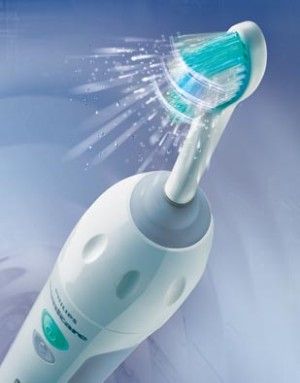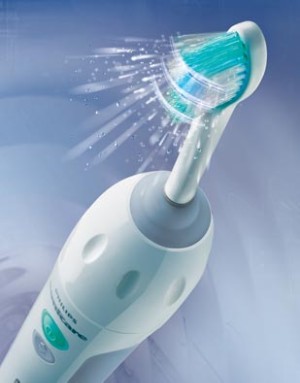
How to Brush Your Teeth with an Electric Powered Toothbrush

Electric toothbrushes are more effective at cleaning teeth than manual toothbrushes, can help prevent tooth staining, and will lower your risk for toothbrush abrasion. If you have the money you should definitely invest in one.
There is a bit of a learning curve to using an electric toothbrush correctly. Since the brushing motion is done entirely by the toothbrush, all you have to do is position the toothbrush head so the bristles reach the right areas. Since the shape of the electric toothbrush head can be different than manual toothbrushes, I recommend taking some time to get used to the toothbrush before ever turning it on. Also, the vibrations of the toothbrush can be distracting and a bit disorienting for some people in the beginning, so it is helpful to first practice positioning the toothbrush go through the motions. We will talk about it before turning on the toothbrush. You have to learn to crawl before you can walk.
Correct brushing technique requires that you develop a sense of where the toothbrush bristles are touching. Everyone’s teeth are different and applying one brushing method to all people simply won’t work. You must be able to feel the bristles slightly in between your teeth and also along your gum line so you can individualize your brushing and know you are cleaning the right spots. I find that it is best to start using your electric toothbrush without toothpaste, wetting the bristles just like we did with manual toothbrushes. Without the distraction of the sudsy toothpaste, you can really focus on where the toothbrush bristles are touching.
I wouldn’t worry too much about brushing without toothpaste. Your teeth will be just as clean without it, and a few days without fluoride (which is why toothpaste is important) so you can get the basics down better in the long run for your teeth. In the meantime, you can still rinse with ACT fluoride mouthwash after brushing to keep your teeth strong.
I wouldn’t worry too much about brushing without toothpaste. Your teeth will be just as clean without it, and a few days without fluoride (which is why toothpaste is important) so you can get the basics down better in the long run for your teeth. In the meantime, you can still rinse with ACT fluoride mouthwash after brushing to keep your teeth strong.
There are two main styles of electric toothbrushes rotation oscillation type powered toothbrushes and side-to-side sonic type electric toothbrushes. The technique for each is slightly different and both are covered below with pictures.
Oral-B Rotating Oscillating Type Powered Toothbrush
Dental plaque forms first in-between teeth and along the gum line, so it is important to focus on these areas during brushing by directing your toothbrush bristles toward your gums at a 45-degree angle just like you would with a manual toothbrush. You should be able to feel the bristles along your gumline.
I follow the same general pattern of cleaning with an electric toothbrush that I do with a manual toothbrush (consult our post on manual toothbrushing for more specifics), the only difference is how each area gets cleaned. Since the toothbrush is doing all the work, you simply need to tilt the toothbrush gently around each tooth to clean slightly in-between teeth and along your gums.
Oral-B style powered toothbrushes have toothbrush heads sized to clean each tooth individually, so slowly rock the toothbrush back and forth along one tooth at a time for about 5 to 10 seconds just like in the pictures below. Be sure to pay attention to the bristles and feel them gently surrounding that tooth as you clean it. Be careful not to push too hard with your toothbrush, but fortunately, most of the newer powered toothbrushes warn you if you are using too much force.
Slowly clean tooth to tooth going around the outside of all your teeth first and then the tongue side before finishing up by cleaning the chewing surfaces of your back teeth. Keep in mind when you get to your front teeth you may need to hold the toothbrush vertically so that you can rock the toothbrush back and forth to clean around those teeth.
Sonicare Side-to-Side Type Powered Toothbrush
Just like with all toothbrushes make sure you direct the bristles at a 45-degree angle towards your gums, to clean along the gum line where plaque forms first.
Sonicare electric toothbrushes are shaped much like traditional manual toothbrushes so there is a tendency to incorrectly scrub like a manual toothbrush, but the same back-and-forth rocking motion that we used to clean teeth with the rotating oscillating toothbrush still applies.
Spend about 5 to 10 seconds per area, rocking around the teeth just like in the pictures below. Pay close attention to how the bristles feel around your teeth, so you can verify that they are going slightly between your teeth and along your gum line. Because of the intense vibrations of the Sonicare toothbrush, it is a good idea with this toothbrush to practice going through the motions with the toothbrush off first.
Slowly clean around the outside of all your teeth first one area at a time and then the tongue side before finishing up by cleaning the chewing surfaces of your back teeth. As you get to your front teeth while you are cleaning you may need to hold the toothbrush vertically so that you can rock the toothbrush back and forth to clean around those teeth as you see in the pictures below.
If you encounter any tricky areas, try to visualize where the bristles need to be to clean the area first and then feel for them getting to the right spot. Focusing on feeling the toothbrush bristles is the only surefire way to keep your teeth spotless. Once you have mastered brushing without toothpaste and are ready for the next step, look into getting a low-abrasive toothpaste.